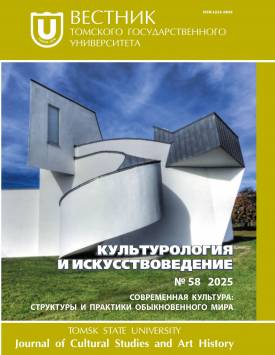Can the AI criticize artwork?
The article is devoted to the problem of the possibility of artificial intelligence to act as an instance of art criticism. The relevance of the research is determined by the fact that AI is rapidly developing, gradually getting involved in the quality of analyzing and evaluating an artwork. At the same time, AI, using the technology of “deep learning”, the technical basis of which is constantly being improved, sets the trend of gaining independence from humans. In the future, AI may become an independent critic. The aim of the study is to identify in the increasing role of AI in art criticism. The main research method in this study is philosophical analysis. The scientific novelty consists in investigating the feasibility and legitimacy of AI participation in art criticism, as well as in identifying its philosophical and theoretical premises. The article notes that AI already has a relatively developed ability to analyze works of art. AI is evolving towards understanding its capabilities from initially quantifying works of art to form artistic and aesthetic evaluation in different genres of art: visual arts, music, poetry, etc. This is prompting critics, artists, musicians and poets alike to reflect on the relationship between art and technology and the impact of the latter on the perception of art itself. AI is taking its first steps in the field of art criticism, but it already surpasses critics in some moments, for example, in recognizing the same hands or faces in the works of the same artist, as well as in evaluating music according to several parameters, including pitch and rhythm. The author declares no conflicts of interests.
Keywords
art criticism,
artificial intelligence,
art work,
technology,
subjectivityAuthors
| Jiang Chaoran | Saint Petersburg University | chaoranjiang@yandex.ru |
Всего: 1
References
Критика цифрового разума / гл. ред. В. Савчук. СПб. : Академия исследования культуры, 2018. 295 с.
工业和信息化蓝皮书 人工智能发展报告 2023-2024 . 蒋艳主编. 北京: 社会科学文献出版社, 2024. [Синяя книга промышленности и информатизации: доклад о развитии искусственного интеллекта (2023-2024) (2024) / гл. ред. Цзян Янь. Пекин : Шэхуэй кэсюе вэньсянь чубаньшэ].
刘建平. 文艺批评 人工智能及其挑战 // 学术界. 2021. № 5. Р. 70-80. [Литературная и художественная критика: искусственный интеллект и его проблемы // Сюешу Цзэ. 2021. № 5. С. 70-80.].
郑耀东. 边界的突破与扩展 对人工智能美术创作的理性审思 // 艺术百家. 2021. № 6. Р. 54-59. [Разрушение и расширение границ: рациональные размышления о художественном творчестве ИИ // Иъшу Байцзя. 2021. № 6. С. 54-59.].
刘洁. “无人的音乐”--从编码器到人工智能作曲的主体异位 // 天津社会科学. 2022. № 2. Р. 117-121. [«Музыка без человечества» - субъективное отчуждение от кодировщиков до композиции ИИ // Тяньцзинь Шэхуэй Кэсюе. 2022. № 2. С. 117-121.].
Сыров С. Робот-композитор Шимон. 2017. URL: https://22century.ru/computer-it/51283 (дата обращения: 22.10.2024).
Васильков А. ИИ как цифровой Рембрандт. 2016. URL: https://www.computerra.ru/180213/ai-as-digital-rembrandt/ (дата обращения: 22.10.2024).
Первую картину интеллектуальной машины продали почти за полмиллиона долларов. 2018. URL: https://arthive.com/zh/news/3666~Pervuju_kartinu_intellektual'noj_mashiny_prodali_pochti_za_polmilliona_dollarov (дата обращения: 22.10.2024).
Industrial Art: Microsoft AI Xiaoice has solo exhibition in Beijing. 2019. URL: https://news.cgtn.com/news/356b544e794d4464776c6d636a4e6e62684a4856/index.html (дата обращения: 22.10.2024).
中国当代艺术年鉴2016. 朱青生主编. 广西: 广西师范大学出版社, 2018. [Ежегодник современного искусства Китая 2016 (2018) / гл. ред. Чжу Циншэн, Гуанси: Гуанси шифань дасюе чубаньшэ.].
Ugail H., Stork D., Edwards H., Seward S., Brooke C. Deep transfer learning for visual analysis and attribution of paintings by Raphael // Heritage Science. 2023. № 268. doi: 10.1186/s40494-023-01094-0.
Ugail H., Edwards H., Benoy T., Brooke C. Deep Facial Features for Analysing Artistic Depictions - A Case Study in Evaluating 16th and 17th Century Old Master Portraits // 2022 14th International Conference on Software, Knowledge, Information Management and Applications (SKIMA), Phnom Penh, Cambodia. 2022. P. 198-203. doi: 10.1109/SKIMA57145.2022.10029439.
Ma zhe, Xiang Zhenzhen, Su Jianbo. Robust visual servoing based Chinese calligraphy on a humanoid robot // High Technology Letters. 2016. № 1. Р. 30-37.
Маклюэн М. Понимание медиа: Внешнее расширение человека. М. : Жуковский, 2003. 464 с.
Cubitt S. Digital aesthetics. London : SAGE Publications Ltd, 1998.
Баррат Дж. Последнее изобретение человечества: Искусственный интеллект и конец эры Homo sapiens. М. : ООО «Альпина нон-фикшн», 2015. 274 с.
彭锋. 当下作为话语生产的艺术批评 // 艺术百家. 2013. № 2. Р. 61-64. [Художественная критика как дискурсивное производство в настоящем // Иъшу Байцзя. 2013. № 2. С. 61-64.].
Рансьер Ж. Эстетическое бессознательное. СПб. ; М. : Machina, 2004. 128 с.
Hockett F., Hockett D. The origin of speech // Scientific American. 1960. № 3. Р. 88-97.
Борель Э. Вероятность и достоверность. М. : Наука, 1969. 111 с.
De Duve T. Kant after Duchamp. Cambridge : MIT Press, 1998.
Bernard M. The Amazing Ways How Wikipedia Uses Artificial Intelligence. 2018. URL: https://www.forbes.com/sites/bernardmarr/2018/08/17/the-amazing-ways-how-wikipedia-uses-artificial-intelligence/ (дата обращения: 22.10.2024).
Radford A., Jozefowicz R., Sutskever I. Learning to Generate Reviews and Discovering Sentiment // arXiv. 2017. https://doi.org/10.48550/arXiv.1704.01444.
Магрини М. Мозг. Инструкция пользователя. М. : ACT, 2017. 191 с.
Черниговская Т. Ариадны или Пирожные Мадлен: Нейронная сеть и сознание // В мире науки. 2012. № 4. С. 40-47.
Lacan J. Ecrits: the first complete edition in English. New York : W.W. Norton & Company, 2006.

